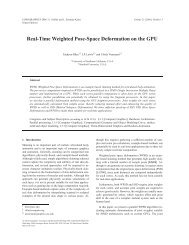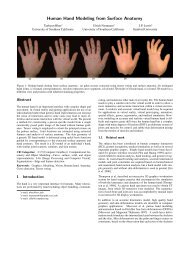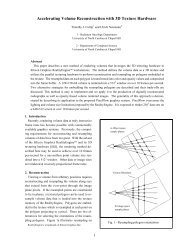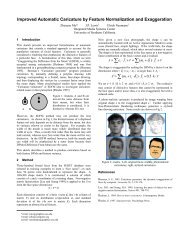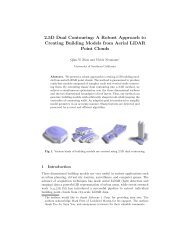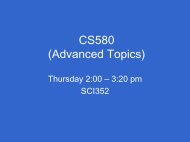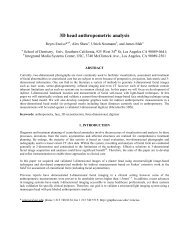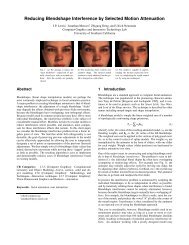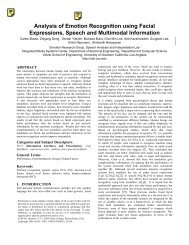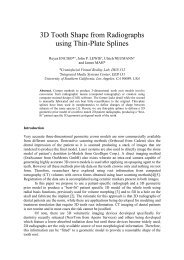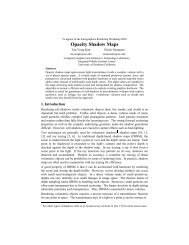The Gixel Array Descriptor (GAD) for Multi-Modal Image Matching
The Gixel Array Descriptor (GAD) for Multi-Modal Image Matching
The Gixel Array Descriptor (GAD) for Multi-Modal Image Matching
You also want an ePaper? Increase the reach of your titles
YUMPU automatically turns print PDFs into web optimized ePapers that Google loves.
<strong>The</strong> array parameters are determined empirically, but are<br />
not critical in our experience. A dense <strong>Gixel</strong> array may lead<br />
to redundancy and unnecessary complexity, as <strong>Gixel</strong>s close<br />
to each other will sample similar gradient in<strong>for</strong>mation. On<br />
the other hand, too few or too sparse a <strong>Gixel</strong> array will reduce<br />
the discriminative power of the descriptor, and result<br />
in low feature dimension or low correlation between <strong>Gixel</strong>s.<br />
In our experiments, we use fixed parameters of 3 circles, 8<br />
<strong>Gixel</strong>s on each circle, and the distance between each circle<br />
is 50 pixels (which means the radius is 50, 100, 150 from<br />
the center <strong>Gixel</strong>). Thus there are 3 ∗8+1 = 25 <strong>Gixel</strong>s in<br />
total, resulting in a feature dimension of 50.<br />
A circular <strong>Gixel</strong> array also has several other benefits.<br />
It’s easy to generate and reproduce. Each <strong>Gixel</strong> in the array<br />
samples the region evenly. Most importantly, it can be<br />
adapted to achieve rotation and scale invariance by rotating<br />
<strong>Gixel</strong>s on the circle and adjusting circle radius (refer to<br />
Sec.5.3), as shown in Fig.3(b).<br />
3.3. <strong>Descriptor</strong> Localization and <strong>Matching</strong><br />
Unlike descriptors such as SIFT or SURF, which require<br />
a keypoint detection step, <strong>GAD</strong> can be computed with any<br />
detector or at any arbitrary location, while still maintaining<br />
good per<strong>for</strong>mance even under multi-modal situations, due<br />
to its smoothness property (Sec.4.1). In practice we find<br />
that a simple keypoint detection step like the Harris corner<br />
detector can be used to identify areas with gradients to<br />
speed up the matching process.<br />
<strong>The</strong> distance between two descriptors is computed as the<br />
square root of squared difference of the two vectors. Two<br />
descriptors on two images are considered matched if the<br />
nearest neighbor distance ratio [1] is larger than a threshold.<br />
<strong>The</strong> nearest neighbor distance ratio is defined as the<br />
ratio of distance between the first and the second nearest<br />
neighbors.<br />
4. Analysis of Advantages<br />
4.1. Smoothness<br />
<strong>The</strong> design of <strong>GAD</strong> takes special care to achieve its<br />
smoothness property, both in how gradients are scored, and<br />
in how the neighborhood size of each <strong>Gixel</strong> is determined.<br />
<strong>The</strong> scoring function is defined as a smooth function monotonically<br />
decreasing with length and distance. <strong>The</strong> neighborhood<br />
of each <strong>Gixel</strong> is cut off smoothly, so that the score<br />
is negligible at its boundary, resulting in a circular neighborhood<br />
of 50-pixel radius. A small change in a line segment’s<br />
length, orientation, distance or the location of a <strong>Gixel</strong><br />
sample will only result in a small change in the descriptor.<br />
Moreover, the additive scoring property of a <strong>Gixel</strong> also contributes<br />
to the smoothness by alleviating the impact of noise<br />
and line gaps.<br />
When matching images of a single modality, it is desir-<br />
Figure 4. <strong>Descriptor</strong> similarity score distribution when moving<br />
keypoint in the neighborhood. (a) <strong>GAD</strong>; (b) SURF.<br />
able to use a score function with a sharp peak. Smoothness<br />
may not be an important issue in this case. However,<br />
<strong>for</strong> multi-modal matching, even corresponding regions may<br />
not have exactly the same intensity or gradient distribution.<br />
<strong>The</strong> smoothness property of a <strong>Gixel</strong> makes it more robust<br />
to noise and thus better suited <strong>for</strong> multi-modal applications.<br />
In addition, a <strong>Gixel</strong>-based descriptor relies less on accurate<br />
selection of a keypoint position. This means that keypoint<br />
selection is not critical. Even when keypoints have small<br />
offsets between two images, which is common in multimodal<br />
matching, <strong>Gixel</strong>s can still match them correctly.<br />
On the other hand, traditional descriptors doesn’t exhibit<br />
smoothness, as they usually divides pixels and gradients into<br />
small bins and makes numerous binary decision or selections.<br />
Comparison-based descriptors are even worse, because<br />
noise or keypoint variations might change the pixel<br />
position and ordering completely.<br />
Figure 4 shows the distribution of matching similarity<br />
score between two descriptors in corresponding regions (of<br />
Fig.5), when one of the descriptor is moving. <strong>The</strong> <strong>Gixel</strong> descriptor<br />
(Fig.4(a)) demonstrates better smoothness and distinctiveness<br />
(single peak) than SURF (Fig.4(b)).<br />
4.2. <strong>Multi</strong>-<strong>Modal</strong> <strong>Matching</strong><br />
Line features are the most important and sometimes the<br />
only available feature in multi-modal matching problems.<br />
Each <strong>Gixel</strong> in the descriptor array samples and scores the<br />
line features in its neighborhood from a different distance<br />
and orientation. In other words, the <strong>Gixel</strong>s sample overlapping<br />
regions of edge in<strong>for</strong>mation, but from different locations.<br />
This spatial distribution of samples imparts the final<br />
descriptor with its discriminating power.<br />
On the other hand, traditional distribution-based descriptors<br />
tend to break a long line feature into individual grid or<br />
bin contributions. Noisy line rendering and detection might<br />
impact the distribution statistics heavily, making the matching<br />
process unreliable.<br />
<strong>Descriptor</strong>s based on pixel-wise comparison may also<br />
suffer in multi-modal matching, as the lack of texture will<br />
not provide enough distinctive pixel pairs to work robustly.



